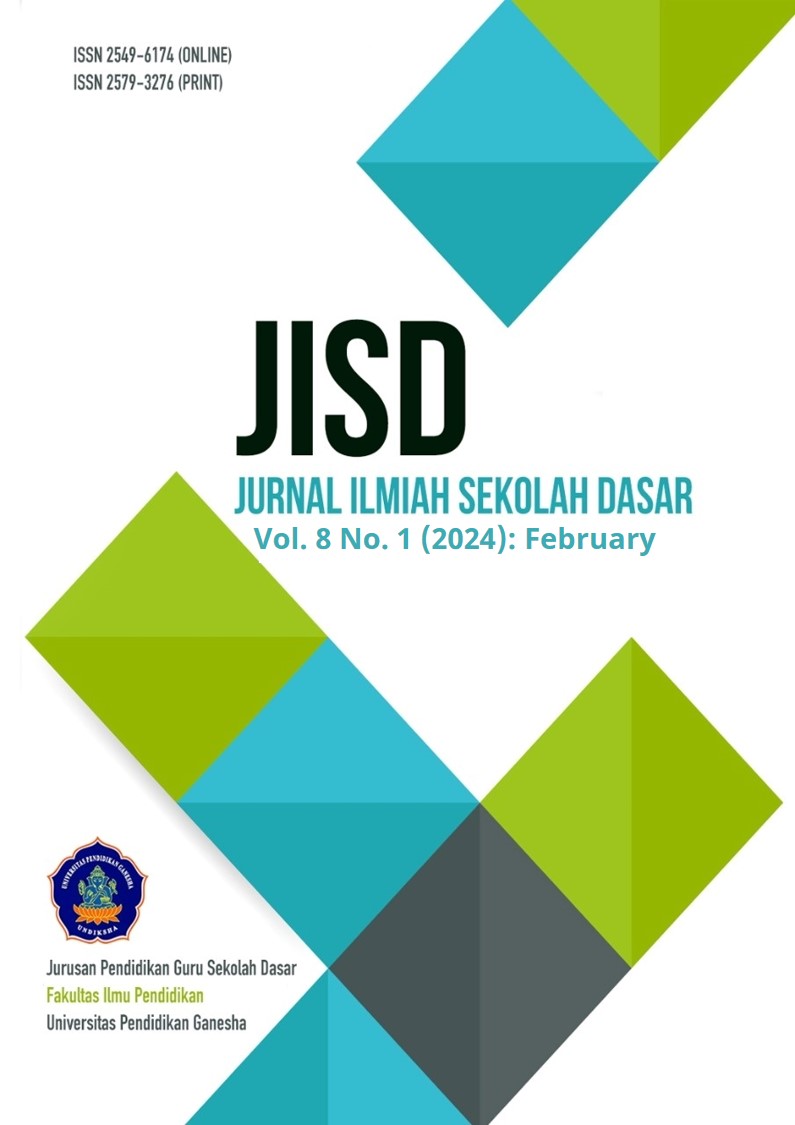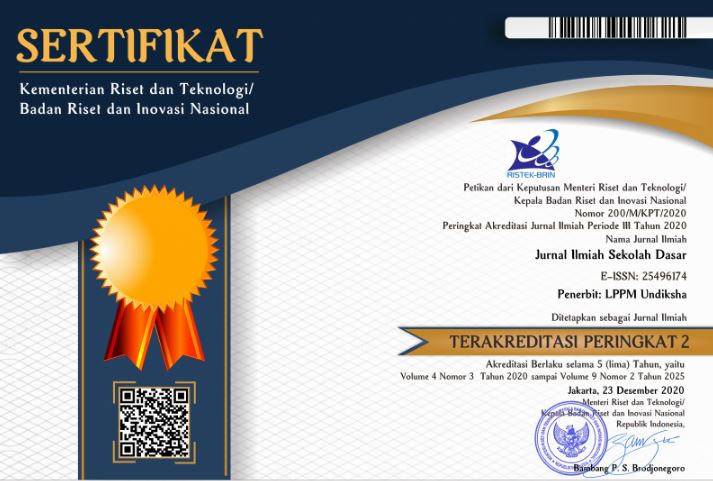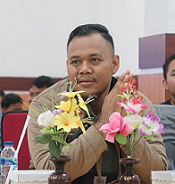Emibaru: Interactive E-Modules Based on Problem Solving Ability for Fifth Grade Students in Elementary School
DOI:
https://doi.org/10.23887/jisd.v8i1.59673Keywords:
Interactive E-Module, Geometry, Problem SolvingAbstract
Creating meaningful learning is crucial to accommodate students’ problems solving ability development. This research is motivated by the low problem-solving ability of elementary school students in solving mathematical word problems, hence the need for teachers to make an effort in developing teaching materials for students to improve their mathematical problem-solving abilities. This study aims to develop a spatial interactive e-module (Emibaru) and evaluate the problem-solving abilities of 5th-grade students in using the interactive e-module. The quantitative approach and quasi-experimental method with a pretest-post-test control group design were applied in this research. The sampling technique was simple random sampling with 12 students from the experimental group and nine from the control group. Data collection techniques are interviews, observations, and tests. The instruments used were interview sheets, observation sheets, and essay tests. The data analysis technique used the T-test assisted by the SPSS 23 application. The results based on the T-test analysis showed t 2.237 and the value of Sig. (2-tailed) is 0.037 at df 19 < 0.05. It was stated that the spatial interactive e-module (Emibaru) influenced problem-solving mathematical competence in geometric materials (cubes and blocks).
References
Acar, S., Chen, C. I., & Xie, H. (2021). Parental involvement in developmental disabilities across three cultures: A systematic review. Research in Developmental Disabilities, 110(December 2020), 103861. https://doi.org/10.1016/j.ridd.2021.103861. DOI: https://doi.org/10.1016/j.ridd.2021.103861
Aisy, D. R., Farida, F., & Andriani, S. (2020). Pengembangan E-Modul Berbantuan Sigil Software Dengan Pendekatan Saitifik Pada Materi Sistem Persamaan Linier Dua Variabel (Spldv). Edu Sains Jurnal Pendidikan Sains & Matematika, 8(1), 61–71. https://doi.org/10.23971/eds.v8i1.1499. DOI: https://doi.org/10.23971/eds.v8i1.1499
Anderha, R. R., & Maskar, S. (2020). Analisis Kemampuan Komunikasi Matematis Siswa Pada Pembelajaran Daring Materi Eksponensial. Jurnal Ilmiah Matematika Realistik, 1(2), 1–7. https://doi.org/10.33365/ji-mr.v1i2.438. DOI: https://doi.org/10.33365/ji-mr.v1i2.438
Apriani, F. (2018). Kesalahan Mahasiswa Calon Guru Sd Dalam Menyelesaikan Soal Pemecahan Masalah Matematika. Journal Of Mathematics Science And Education, 1(1), 102–117. https://doi.org/10.31540/jmse.v1i1.167. DOI: https://doi.org/10.31540/jmse.v1i1.167
Argarini, D. F. (2018). Analisis Pemecahan Masalah Berbasis Polya pada Materi Perkalian Vektor Ditinjau dari Gaya Belajar. Matematika Dan Pembelajaran, 6(1), 91. https://doi.org/10.33477/mp.v6i1.448 DOI: https://doi.org/10.33477/mp.v6i1.448
Aspriyani, R., & Suzana, A. (2020). Pengembangan E-Modul Interaktif Materi Persamaan Lingkaran Berbasis Realistic Mathematics Education Berbantuan Geogebra. AKSIOMA: Jurnal Program Studi Pendidikan Matematika, 9(4), 1099. https://doi.org/10.24127/ajpm.v9i4.3123. DOI: https://doi.org/10.24127/ajpm.v9i4.3123
Asri, Y. N. (2018). Pembelajaran Berbasis Stem Melalui Pelatihan Robotika. WaPFi (Wahana Pendidikan Fisika), 3(2), 74. https://doi.org/10.17509/wapfi.v3i2.13735. DOI: https://doi.org/10.17509/wapfi.v3i2.13735
Bernard, M., Akbar, P., Ansori, A., & Filiestianto, G. (2019). Improve the ability of understanding mathematics and confidence of elementary school students with a contextual approach using VBA learning media for Microsoft Excel. Journal of Physics: Conference Series, 1318(1). https://doi.org/10.1088/1742-6596/1318/1/012035. DOI: https://doi.org/10.1088/1742-6596/1318/1/012035
Blumberg, F. C., & Fisch, S. M. (2013). Introduction: Digital games as a context for cognitive development, learning, and developmental research. New Directions for Child and Adolescent Development, 139, 1–9. https://doi.org/10.1002/cad.20026. DOI: https://doi.org/10.1002/cad.20026
Buchori, A. (2019). Pengembangan multimedia interaktif dengan pendekatan kontekstual untuk meningkatkan pemecahan masalah kemampuan matematika. Jurnal Inovasi Teknologi Pendidikan, 6(1), 104–115. https://doi.org/10.21831/jitp.v6i1.20094. DOI: https://doi.org/10.21831/jitp.v6i1.20094
Darmaji, Kurniawan, D. A., Astalini, Winda, F. R., Heldalia, & Kartina, L. (2020). The Correlation between Student Perceptions of the Use of E- Modules with Students ’ Basic Science Process Skills. Jurnal Pendidikan Indonesia, 9(4), 719–729. https://doi.org/http://dx.doi.org/10.23887/jpi-undiksha.v9i4.28310. DOI: https://doi.org/10.23887/jpi-undiksha.v9i4.28310
Daulay, K. R., & Ruhaimah, I. (2019). Polya theory to improve problem-solving skills. Journal of Physics: Conference Series, 1188(1). https://doi.org/10.1088/1742-6596/1188/1/012070. DOI: https://doi.org/10.1088/1742-6596/1188/1/012070
Ghulam Behlol, M., Akbar, A., & Sehrish, H. (2018). Effectiveness of Problem Solving Method in Teaching Mathematics at Elementary Level. Bulletin of Education and Research, 40(1), 245–258. https://eric.ed.gov/?id=EJ1209742.
Gunadi, G., Haryono, H., Purwanti, E., Raya, B. R., Pinoh Barat Melawi, T., & Kalimantan, W. (2022). The Analysis of 21 st Century Learning Implementation and Competency Achievement of Junior High School Students in 3T Regions. Innovative Journal of Curriculum and Educational Technology, 11(1), 10–18. https://doi.org/10.15294/IJCET.V11I1.44847. DOI: https://doi.org/10.15294/ijcet.v11i1.44847
Gupta, T., Burke, K. A., & Greenbowe, T. J. (2022). Shifting the ownership of learning from instructor to students through student-led instructor-facilitated guided-inquiry learning. In Teaching Innovation in University Education: Case Studies and Main Practices, 69–98. https://doi.org/10.4018/978-1-6684-4441-2.ch005. DOI: https://doi.org/10.4018/978-1-6684-4441-2.ch005
Haataja, E., Garcia Moreno-Esteva, E., Salonen, V., Laine, A., Toivanen, M., & Hannula, M. S. (2019). Teacher’s visual attention when scaffolding collaborative mathematical problem solving. Teaching and Teacher Education, 86. https://doi.org/10.1016/j.tate.2019.102877. DOI: https://doi.org/10.1016/j.tate.2019.102877
Harefa, D., & Laia, H. T. (2021). Media Pembelajaran Audio Video Terhadap Kemampuan Pemecahan Masalah Matematika Siswa. AKSARA: Jurnal Ilmu Pendidikan Nonformal, 7(2), 329–338. https://doi.org/10.37905/aksara.7.2.327-338.2021. DOI: https://doi.org/10.37905/aksara.7.2.327-338.2021
Hayyulbathin, I., Winarni, R., & Murwaningsih, T. (2011). Modification of Polya’s Step to Solve Math Story Problem. 5th ICRIEMS Proceedings, 119–126. http://seminar.uny.ac.id/icriems/sites/seminar.uny.ac.id.icriems/files/proceeding2018/ME16_Isfa Hayyulbathin.pdf.
Herawati, N. S., & Muhtadi, A. (2018). Pengembangan modul elektronik (e-modul) interaktif pada mata pelajaran Kimia kelas XI SMA. Jurnal Inovasi Teknologi Pendidikan, 5(2), 180–191. https://doi.org/10.21831/jitp.v5i2.15424. DOI: https://doi.org/10.21831/jitp.v5i2.15424
Hwang, G. J., Wang, S. Y., & Lai, C. L. (2021). Effects of a social regulation-based online learning framework on students’ learning achievements and behaviors in mathematics. Computers and Education, 160(1), 104031.1-5. https://doi.org/10.1016/j.compedu.2020.104031. DOI: https://doi.org/10.1016/j.compedu.2020.104031
Ismiyati, Festiyed, & Hamdi. (2019). Validity of physics learning module based on problem based learning to improve students metacognitive skills. Journal of Physics: Conference Series, 1185(1). https://doi.org/10.1088/1742-6596/1185/1/012066. DOI: https://doi.org/10.1088/1742-6596/1185/1/012066
Isnaini, N., Ahied, M., Qomaria, N., & Munawaroh, F. (2021). Kemampuan Pemecahan Masalah Berdasarkan Teori Polya Pada Siswa Kelas Viii Smp Ditinjau Dari Gender. Natural Science Education Research, 4(1), 84–92. https://doi.org/10.21107/nser.v4i1.8489. DOI: https://doi.org/10.21107/nser.v4i1.8489
Juandi, D. (2021). Heterogeneity of problem-based learning outcomes for improving mathematical competence: A systematic literature review. Journal of Physics: Conference Series, 1722(1). https://doi.org/10.1088/1742-6596/1722/1/012108. DOI: https://doi.org/10.1088/1742-6596/1722/1/012108
Juwantara, R. A. (2019). Analisis Teori Perkembangan Kognitif Piaget Pada Tahap Anak Usia Operasional Konkret 7-12 Tahun Dalam Pembelajaran Matematika. Al-Adzka: Jurnal Ilmiah Pendidikan Guru Madrasah Ibtidaiyah, 9(1), 27–34. https://core.ac.uk/download/pdf/327227393.pdf. DOI: https://doi.org/10.18592/aladzkapgmi.v9i1.3011
Khasanah, U., Rahayu, R., & Ristiyani. (2021). Analisis Kemampuan Pemecahan Masalah Matematis Siswa Kelas IV Materi Bangun Datar Berdasarkan Teori Polya. Jurnal Didaktika, 1(2), 230–242. https://doi.org/10.17509/didaktika.v1i2.36538. DOI: https://doi.org/10.17509/didaktika.v1i2.36538
Kho, R., & Tyas, D. K. N. (2020). Pelatihan Pembuatan Alat Peraga Matematika bagi Guru-guru SD YPK Yoka Baru Waena Kota Jayapura. JISIP (Jurnal Ilmu Sosial Dan Pendidikan), 4(2). https://doi.org/10.58258/jisip.v4i2.1072. DOI: https://doi.org/10.58258/jisip.v4i2.1072
Lampropoulos, G., Siakas, K., & Anastasiadis, T. (2019). Internet of Things in the Context of Industry 4.0: An Overview. International Journal of Entrepreneurial Knowledge, 7(1), 4–19. https://doi.org/10.2478/ijek-2019-0001. DOI: https://doi.org/10.2478/ijek-2019-0001
Mulyati, T. (2016). Kemampuan Pemecahan Masalah Matematis Siswa Sekolah Dasar. EduHumaniora | Jurnal Pendidikan Dasar Kampus Cibiru, 3(2). https://doi.org/10.17509/eh.v3i2.2807. DOI: https://doi.org/10.17509/eh.v3i2.2807
Mustika, M., Sugara, E. P. A., & Pratiwi, M. (2017). Pengembangan Media Pembelajaran Interaktif dengan Menggunakan Metode Multimedia Development Life Cycle. Jurnal Online Informatika, 2(2), 121–126. https://doi.org/10.15575/join.v2i2.139. DOI: https://doi.org/10.15575/join.v2i2.139
Nurdiana Hidayanti, E., Setia wardana, M. Y., & Prima Artharina, F. (2022). Analisis Kemampuan Pemecahan Masalah Matematis Dalam Menyelesaikan Soal Cerita Berdasarkan Langkah- Langkah Polya Pada Siswa Kelas III SD Negeri Muntung Temanggung. Praniti: Jurnal Pendidikan, Bahasa, Dan Sastra, 2(1), 36–42. https://jurnal.unw.ac.id/index.php/praniti/article/view/1476.
Nurkaeti, N. (2018). Polya’S Strategy: an Analysis of Mathematical Problem Solving Difficulty in 5Th Grade Elementary School. EduHumaniora | Jurnal Pendidikan Dasar Kampus Cibiru, 10(2), 140. https://doi.org/10.17509/eh.v10i2.10868. DOI: https://doi.org/10.17509/eh.v10i2.10868
Oludare Jethro, O., Moradeke Grace, A., & Kolawole Thomas, A. (2012). E-Learning and Its Effects on Teaching and Learning in a Global Age. International Journal of Academic Research in Business and Social Sciences, 2(1), 2222–6990. https://www.researchgate.net/profile/Grace-Adewumi-2/publication.
Penagos-Vásquez, D., Graciano-Uribe, J., García, S. V., & Rio, J. S. (2021). Characteristic Curve Prediction of a Commercial Centrifugal Pump Operating as a Turbine Through Numerical Simulations. Journal of Advanced Research in Fluid Mechanics and Thermal Sciences, 83(1), 153–69. https://doi.org/10.37934/arfmts.83.1.153169. DOI: https://doi.org/10.37934/arfmts.83.1.153169
Rahayu, R., Nuryani, P., & Hermawan, R. (2019). Penerapan Model PBL untuk Meningkatkan Keterampilan Berpikir Kritis pada Pelajaran IPS SD. Jurnal Pendidikan Guru Sekolah Dasar, 4(2), 93–101. https://doi.org/10.17509/jpgsd.v4i2.20488.
Restina, R., Asmara, D. N., & Husni, R. (2021). Pengembangan E-Module Pembelajaran Matematika Pada Siswa Kelas V Sd Negeri 14 Koto Baru. Jurnal IKA PGSD (Ikatan Alumni PGSD) UNARS, 9(1), 319. https://doi.org/10.36841/pgsdunars.v9i1.1124. DOI: https://doi.org/10.36841/pgsdunars.v9i1.1124
Rostika, D., & Junita, H. (2017). Peningkatan Kemampuan Pemecahan Masalah Siswa SD dalam Pembelajaran Matematika dengan Model Diskursus Multy Representation (DMR). EduHumaniora : Jurnal Pendidikan Dasar, 9(1), 35–46. https://doi.org/10.17509/eh.v9i1.6176. DOI: https://doi.org/10.17509/eh.v9i1.6176
Septianti, N., & Afiani, R. (2020). Pentingnya Memahami Karakteristik Siswa Sekolah Dasar Di SDN Cikokol 2. As-Sabiqun: Jurnal Pendidikan Islam Anak Usia Dini, 2(1), 7–17. https://doi.org/10.36088/assabiqun.v2i1.611. DOI: https://doi.org/10.36088/assabiqun.v2i1.611
Sulistyaningrum, H., Winata, A., & Cacik, S. (2019). Analisis Kemampuan Awal 21st Century Skills Mahasiswa Calon Guru SD. Jurnal Pendidikan Dasar Nusantara, 5(1), 142. https://doi.org/10.29407/jpdn.v5i1.13068. DOI: https://doi.org/10.29407/jpdn.v5i1.13068
Suntani, Tatang, U., Sasongko, Nur, R., Kristiawan, Walid, M., Ahmad, Kusumah, & Tamrin, R. G. (2021). The Role of Principal Interpersonal Communication on Teacher’s Work Motivation. Education Quarterly Reviews, 4(2). https://doi.org/10.31014/aior.1993.04.02.206. DOI: https://doi.org/10.31014/aior.1993.04.02.206
Syafitri, N. U., Damayani, A. T., & Saputra, H. J. (2021). Keefektifan Model Pembelajaran RME Berbantu Media Tangram Terhadap Kemampuan Pemecahan Masalah Matematika Materi Bangun Datar Siswa Kelas IV SD Negeri Kauman 07 Batang. Dwijalika Jurnal Pendidikan Dasar & Menengah, 2(3), 322–329.
Ulandari, L., Amry, Z., & Saragih, S. (2019). Development of Learning Materials Based on Realistic Mathematics Education Approach to Improve Students’ Mathematical Problem Solving Ability and Self-Efficacy. International Electronic Journal of Mathematics Education, 14(2), 375–383. https://doi.org/10.29333/iejme/5721. DOI: https://doi.org/10.29333/iejme/5721
Weidinger, A. F., Steinmayr, R., & Spinath, B. (2018). Changes in the Relation Between Competence Beliefs and Achievement in Math Across Elementary School Years. Child Development, 89(2), e138–e156. https://doi.org/10.1111/cdev.12806. DOI: https://doi.org/10.1111/cdev.12806
Widodo, W., Sudibyo, E., Suryanti, Sari, D. A. P., Inzanah, & Setiawan, B. (2020). The effectiveness of gadget-based interactive multimedia in improving generation z’s scientific literacy. Jurnal Pendidikan IPA Indonesia, 9(2), 248–256. https://doi.org/10.15294/jpii.v9i2.23208. DOI: https://doi.org/10.15294/jpii.v9i2.23208
Yuwono, T., Supanggih, M., & Ferdiani, R. D. (2018). Analisis Kemampuan Pemecahan Masalah Matematika dalam Menyelesaikan Soal Cerita Berdasarkan Prosedur Polya. Jurnal Tadris Matematika, 1(2). https://doi.org/10.21274/jtm.2018.1.2.137-144. DOI: https://doi.org/10.21274/jtm.2018.1.2.137-144
Downloads
Published
How to Cite
Issue
Section
License
Copyright (c) 2024 Fery Muhamad Firdaus, Vaziana Qatrunnada Salmawati, Lenia Dwi Normayani

This work is licensed under a Creative Commons Attribution-ShareAlike 4.0 International License.
Authors who publish with the Journal Ilmiah Sekolah Dasar agree to the following terms:
- Authors retain copyright and grant the journal the right of first publication with the work simultaneously licensed under a Creative Commons Attribution License (CC BY-SA 4.0) that allows others to share the work with an acknowledgment of the work's authorship and initial publication in this journal.
- Authors are able to enter into separate, additional contractual arrangements for the non-exclusive distribution of the journal's published version of the work (e.g., post it to an institutional repository or publish it in a book), with an acknowledgment of its initial publication in this journal.
- Authors are permitted and encouraged to post their work online (e.g., in institutional repositories or on their website) prior to and during the submission process, as it can lead to productive exchanges, as well as earlier and greater citation of published work. (See The Effect of Open Access)










